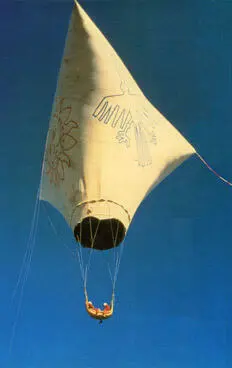Great use, he thought, there might be made
Of these machines in his own trade;
Now o’er a fortress he might soar
And its condition thence explore
Or when by mountains, woods, or bog
An enemy might lie incog
Our friend would o’er their station hover
Their strength, their route, and views discover;
Then change his course, and straight impart
Glad tidings to his chieftain’s heart … 6
These were all to prove strangely prophetic.
The experience of ballooning is in a sense timeless. Man-carrying balloons are both extremely modern and extremely primitive devices. In their contemporary form, powered by stainless-steel propane-gas burners and using rip-stop nylon envelopes, they were virtually reinvented in 1960 by an American, Ed Yost, experimenting in Nebraska. His ideas were quickly taken up by Don Cameron and others in Britain and France. 7It should not be forgotten that these reinvented balloons were contemporary with the first moon landings and the earliest communication satellites.
But balloons are also ancient and symbolic devices. They have a long history, and a longer mythology, going back in various forms and dimensions thousands of years, to ancient civilisations in South America and China. There are vague accounts of man-carrying smoke balloons from the Yin dynasty of the twelfth century BC. The great scholar and Sinologist Joseph Needham suggested that Chinese of the fourth century BC used fire balloons for signalling in warfare, or perhaps for carrying love letters. There are rumours of shamanic balloon flights made by the priests of the pre-Inca civilisations. Peruvian funereal rituals involved sending corpses out over the Pacific by hot-air balloon, just as the Vikings would later send out their sacred dead by fireboat into the North Sea. The famous geometrical carvings on the Nazca plateau in southern Peru, some of them animal shapes stretching over four miles in outline, are only explicable if they were originally designed to be viewed from hundreds of feet in the air, so presumably by balloon.

It has been suggested that the Nazca designs were made by visiting aliens, hovering in flying saucers. fn3But the modern balloonist Julian Nott successfully invented a huge smoke balloon, constructed purely from local materials, to prove that human beings could overfly and supervise the carvings even in the fifth century AD. 9
The primitive and the sophisticated elements of ballooning are often combined. In this way the balloon may have both a practical and a symbolic function, for example when it is used as a means of escape. Among the most remarkable balloon escapes ever made was a flight across the East German border in September 1979. Its daring, and the idea of a symbolic flight from Communism to the free West, so caught people’s imaginations that it was made into an adventure film by Disney, Night Crossing (1982), starring John Hurt and Beau Bridges.
In March 1978 two East German men, Peter Strelzyk and Günter Wetzel, living with their wives and four children at Poessneck, near the East German frontier, began working on several ideas for escaping to West Germany. Strelzyk was an aircraft mechanic and electrician with his own workshop, while Wetzel was a builder and a gifted handyman. Both were brilliant at bricolage , endlessly resourceful and determined. Together they hit upon the idea of secretly constructing a home-made hot-air balloon in Strelzyk’s attic and workshop. There are various accounts of how they came up with this idea, but one is that Wetzel’s sister-in-law gave them an illustrated magazine article about the annual Albuquerque International Balloon Fiesta, the most famous of all hot-air balloon gatherings, launched in New Mexico in 1972. After that they got all their technical information from the Poessneck public library.
Their balloon had to be very large, capable of lifting eight people to a height of at least five thousand feet, to avoid detection by frontier searchlights, and of carrying them at night over a distance of at least ten miles. They spent months surreptitiously assembling suitable materials, building makeshift propane burners and testing various potential balloon fabrics – including cotton sheets, umbrella covers, waterproof-jacket linings and tenting fabric. The work was shared, but Strelzyk specialised in constructing the burners and the sheet-metal balloon platform, while Wetzel worked on the balloon canopy and rigging. He sewed all the curved balloon strips, or gores, together on a pre-war, pedal-operated sewing machine. Everything had to be bought in small quantities from different shops to avoid alerting the network of Stasi informers; they drove as far as Leipzig to cover their purchases, sometimes claiming that they represented camping or sailing clubs. Their balloon trials were carried out at night in remote areas of the Thuringian forest.
In the end, with infinite patience and ingenuity, they built three versions of their escape balloon. The first, a sixty-foot-high cotton balloon with a capacity of seventy thousand cubic feet, failed to inflate properly, due to porous fabric and a weak burner using two domestic propane cylinders. It had to be abandoned and painstakingly destroyed in April 1978. After more than a year of experiments and setbacks, they came up with a second design with a better, four-cylinder burner and tighter fabric. But during this anxious time Günter Wetzel, increasingly haunted by the risks to his family, reluctantly withdrew from the scheme, and began to consider more conventional methods of crossing the border.
The second balloon was designed to take only the three members of the Strelzyk family. Symbolically, they chose American Independence Day, 4 July 1979, for their launch. But the balloon still lacked lifting power. It flew too low, became drenched by rainclouds, and began to sink earthwards just as the border came in sight. The Strelzyks crash-landed in the bare no-man’s land two hundred yards short of the actual frontier fence. By good luck they were just outside the frontier ‘death zone’, where the barbed wire, anti-personnel mines and automatic guns would have proved fatal. Astonishingly, the crumpled shape of the balloon was not immediately spotted by the border guards, probably because of the heavy rain. Under cover of darkness the three Strelzyks scrambled out of the wreckage, collected all the personal belongings they could carry, and somehow managed to slip back undetected to Poessneck, covering nine miles on foot before dawn. But the balloon equipment that they were forced to abandon meant that the Stasi had clues to their identity, and would soon be hot on their trail. Discovery within a matter of weeks was inevitable.
At this desperate moment, the two families joined forces again. Working around the clock, the Strelzyks and the Weltzers constructed a much bigger balloon using piecemeal sections of artificial taffetas and dress materials, hastily purchased from small shops all over East Germany. An electric engine was attached to the sewing machine, and the propane burner was redesigned. In a matter of six weeks they had a new balloon looking like a huge multicoloured quilt. When fully inflated it stood nearly ninety feet high, and had a hot-air capacity of over 140,000 cubic feet, double that of the previous balloon. Its burner was powered by four propane tanks feeding into a simple five-inch-diameter stovepipe, capable of producing a narrow, violent flame which at maximum pressure shot fifty feet into the air – within thirty feet of the inner crown of the balloon. This could in theory lift well over 1,200 pounds (544 kilograms), the equivalent of seven adults and a child plus all the balloon equipment. But everything depended on the durability of the home-made envelope, the strength and direction of the wind, and the general flying conditions (including air temperature and humidity) on the actual night of the flight.
Читать дальше













